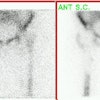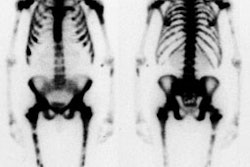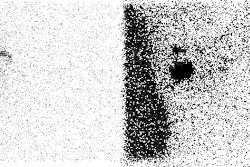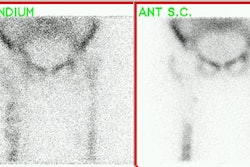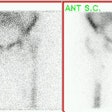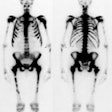Bone Density Measurement:
Osteoporosis is the most common metabolic bone disorder [3].
Osteoporosis is characterized by a decreased volume (or mass) of normal
bone which
results in a decrease in bone strength. It is defined as a skeletal
disorder characterized by compromised bone strength (and increased bone
fragility) predisposing to an increased risk of fracture [2,3]. Bone
strength primarily reflects the integration of bone mineral density and
bone quality (bone quality refers to architecture, turnover,
microfractures, and mineralization) [4]. After a
hip fracture, 20% of patients will die within the next year, 50% of
patients experience some long-term loss of
mobility and up to 20-25% require long term care [3,4]. Patients with
vertebral fractures have less severe complications, and that these
fractures are more frequent, but only 30% come to clinical attention
[4]. Unfortunately, there
is little that can be done to restore lost bone in
older osteoporotic patients.
Osteoporosis can be primary or secondary [3]. Primary osteoporosis
(also known as involutional osteoporosis) results from cumulative bone
loss as people age [3]. Secondary osteoporosis can result from certain
medical conditions or medications [3]. Osteoporosis is commonly
identified in post menopausal women- most likely related
to the decrease in estrogen secretion (primary osteoporosis type I)
[3]. The fracture pattern in this group of patients primarily involves
the spine and wrist [3]. Most women who begin estrogen replacement
therapy at the time of menopause or soon thereafter do not experience
significant bone mineral loss. Osteoporosis can also occur in the
elderly (senile
osteoporosis or primary osteoporosis type II [3]) and in association
with increased parathyroid function. Characteristic fractures of senile
osteoporosis inlcude the hip, proximal humerus, tibia, and pelvis [3].
However, there is consdierable overlap in the types of fractures
experienced by both groups of patients [3]. Other causes of
osteoporosis include corticosteroids (glucocorticoid-induced
osteoporosis is the most common form of secondary osteoporosis [3]),
Cushing disease, prolonged inactivity, and nutritional deficiencies
(malabsorption syndromes such as celiac disease) [1,3]. Regional
osteoporosis affecting only a certain part of the skeleton can occur
secondary to disuse, RSD, or transient osteoporosis of large joints [3].
Although the bone loss involves the entire
skeleton, it is generally more pronounced in the trabecular bone. Thus,
osteoporosis is
associated with fractures of bones that contain a high trabecular
content such as the
vertebral bodies, femoral neck (Ward's triangle), and distal radius.
Bone mineral density (BMD) in the femoral neck declines from the 3rd to
5th decades of life at roughly 0.3% per year [2]. Femoral neck
fractures are especially important because they are associated with a
mortality rate of up
to 12-20% six months after the fracture [3]. Vertebral fractures
typpically occur at the thoracolumbar junction (T12-L1) and the mid
thoracic area (T7 and T8) [3]. Vertebral fractures are multiple in
20-30% of patients [3]. Vertebral fractures are described as "wedge"
fractures when the anterior height is reduced in relation to the
posterior height, "endplate" fractures when the midheight is reduced,
and "crush" fractures when the entire height of the vertebral body is
reduced [3]. Because the posterior height of the thoracic vertebra is
normally 1-3 mm more than the anterior height, a height loss of more
than 4 mm is considered a true vertebral fracture [3].
Bone mineral density (BMD) is the most important determinant of bone
fragility and it is expressed as grams of mineral per area or volume
[4]. The major
potential for bone density measurements is in identifying those
individuals who are at
risk for developing osteoporosis or fracture. Bone density measurements
should be compared
to age-matched, sex-matched, and race-matched controls. The "fracture
threshold"
has been defined as 2.5 standard deviations below the value for a young
normal or below the
90th percentile of values taken from a population who has sustained
osteoporotic
fractures. It has been shown that the risk of hip fracture doubles for
each standard
deviation decline in bone mass.It should be noted that even in the
absence of osteoporotic BMD, the presence of one or more low impact
fragility fractures is considered as a sign of severe osteoporosis [4].
Bone density should be measured in all menopausal women aged 65 y or older, menopausal women under the age of 65 y with one or more risk factors, premenopausal women (age 40 y or more) with one or more low-trauma fractures, women being treated for osteoporosis, and people receiving long-term glucocorticoid therapy [2].
Treatment for low bone density include adequate calcium and vitamin D intake either in the diet or as supplements [2]. Specifically- 1500 mg of calcium daily and 800 units of vitamin D at the age of 80 years and over [2]. Biphosphonates (alendronate, risedronate, ibandronate, and zoledronic acid) can also be used to limit bone resorption and increase bone mass [2]. Osteonecrosis of the jaw is a rare complication of biphosphonate therapy [2]. Calcitonin also inhibits bone resorption, but is not as well tolerated as biphosphonates [2].
Single Photon Absorptiometry:
Single photon absorptiometry (SPA) most commonly utilizes a 150 to 800 mCi source of I-125 collimated to a narrow beam of x-rays and photons (with a range of energies between 27 to 35 keV). Bone mineral density is determined by measuring transmission of the beam. The technique can be used to scan bone which is in a superficial location with little adjacent soft tissue. Excessive soft tissue renders the measurement incorrect. SPA measures both cortical and trabecular bone. The most common sites studied are the mid and distal radius. The calcaneus has also been measured. Unfortunately, the bone mineral density of the radius may not be an accurate reflector of the density in the spine or hip- which are the sites of greatest potential risk for fracture. The skin dose from SPA ranges from 1.5 to 10 mrad.
Dual Photon Absorptiometry:
Dual photon absortiometry (DPA) is used to evaluate the spine or proximal femur. This technique measures both cortical and trabecular bone, but in the spine this measurement is primarily a reflection of trabecular bone. The source is 1 curie of Ga153 which is sealed and collimated. The agent has a half-life of 242 days and emits photons with energies of 44 and 100 keV. There is differential attenuation in bone and soft tissue for each of these photons. From the transmission measurements, along with knowledge of the attenuated and un-attenuated beam intensities at both energies, and the mass attenuation coefficients for bone at both energies, the bone mineral content of the area scanned can be determined. The entrance exposure for DPA is about 12 mR. Falsely increased bone density measurements can be seen with compression fractures, severe aortic calcification, myelographic contrast material, and degenerative sclerotic changes. Falsely low bone mineral density measurements can be seen in association with prior laminectomy, or lytic bone lesions.
Dual X-ray Absorptiometry (DXA):
DXA utilizes an x-ray tube as the radiation source. The device is
pulsed alternatively
at two energies- usually 70 and 140 keV. The attenuation between bone
and soft tissue is
greater for the low energy beam. By entering both attenuation profiles
into an equation,
the soft tissues can be subtracted and an attenuation profile of the
bony components can be calculated [3,4]. The radiation dose from
the procedure is only about 1/1000 of that from a routine spine film.
The major advantages
of this technique are improved resolution, improved image quality, and
a reduction in scan
time from 20-40 minutes, to just 2 to 5 minutes. Accuracy of a DXA
machine is an expression of how well the results obtained with the
machine reflect the true bone mineral content [1].
DXA has a high precision and low radiation exposure (about 50 microsieverts or 5 mrad) [4]. Precision is a reflection of the reproducibility of repeat measurements [1]. The high photon flux of a DXA unit improves precision from 2 to 4%, to about 1% [1]. However, because it is a two-dimensional technique, DEXA cannot distinguish between cortical and trabecular bone and cannot help discriminate between changes due to bone geometry [3]. Generally, the exam should be repeated at most every two years [1]. Exceptions include cases in which patients are starting corticosteroid therapy and those who have undergone orchiectomy [1].
DXA is indicated in women aged 65 years and older, as well as younger perimenopausal women with risk fractors for fragility fractures [4]. Additionally, men 70 years and older and younger men with risk factors for fractures should also undergo DXA [4]. A standard examination includes imaging of the lumbar spine and proximal femur. Routine DXA analysis of the femur provides data for the femoral neck, trochanter, and Ward's triangle (which is the area of least density in a smaller area within a search area centered on the midline at the inferior edge of the femoral neck triangle). The ROI for the total hip or the femoral neck is best used for fracture risk estimation, although the total hip measurement is best used for followup because precision is greater given the larger sample size [1].
Lumbar spine density is obtained as an average from L1 to L4. Measurements of the spine may not accurately reflect bone density because of confounding factors such as degenerative disease with discogenic sclerosis, compression fractures, and aortic calcification. The fewer the number of vertebral bodies analyzed, the greater the potential for errors in accuracy and precision [1]. Diagnostic inferences should not be based solely upon evaluation of only one or two vertebral bodies [1]. Lateral examinations of the spine are possible with DXA and this will help in the identification of and correction for degerative changes and vascular calcifications. Unfortunately, on the lateral view usually only the L3 and L4 vertebrae are free of superimposition of the iliac crest or ribs.
The T-score describes the difference between the BMD of the patient
and the mean BMD of a standard young adult population (20-30 years of
age) matched for sex and ethnicity [3,4]. A normal value for bone
mineral density (BMD) is within one
standard deviation (T-score) of the young adult reference mean [1]. Low
bone mass (osteopenia) is defined as a BMD between 1 and 2.4 standard
deviation (SD) below the young adult reference mean [1]. Osteoporosis
is defined as 2.5 SD below the young adult mean [1]. Severe
osteoporosis is defined as 2.5 SD below and one or more prevalent
low-trauma fractures (from falls from a standing height or equivalent)
[2]. The Z-score shows the difference between the patients BMD and the
mean BMD of age-and gender-matched controls [3]. The Z-score is
particularly important in patients aged 75 years and older [3]. The
ISCD has introduced guidelines for DXA in premenopausal women, men
under the age of 50 years, and children- in these populations a Z-score
of lower than -2 is defined as "below the expected range for age"
(osteoporosis cannot be defined using DXA BMD alone in these
populations [4].
BMD accounts for about 60-70% of bone strength (other suggest
BMD
accounts for 75-85% of bone strength [3]) [2,4]. There are a number of
risk factors which relate to fracture risk including low BMD, family
history or osteoporosis or hip fracture, thin or low body mass,
glucocorticoid use, smoking, more than 2 alcoholic drinks per day, low
calcium and vitamin D intake, and anything that increases the risk of
falling [2]. As such, it may be best to incorporate BMD into a more
broadly based fracture risk assessment profile [2]. The relative risk
for fracture in an osteopenic patient ranges from barely perceptible at
T = -1.1 to virtually the same as that of an osteoporotic patient at T=
-2.4 [2]. The risk of fracture increases approximately 1.5 fold for
each SD decrease from age-adjusted BMD [3].
In order to properly perform the exam, patients need to remain motionless as movement can affect the accuracy of the BMD measurement [1]. Patients should be able to straighten the lumbar spine and internally rotate the hip [1]. Because of small seasonal variations in BMD, successive exams should be performed in the same season [1]. BMD measurements can be affected by substantial weight gain or loss as BMD measurements with DXA correlate with total body fat mass [1]. Contraindications to the exam include the presence of barium within the bowel, or recent administration of radionuclides (within 10 half-lives of the injected agent) which can result in inaccurate BMD measurements [1]. Metallic or radio-opaque implants at the site to be measured will also affect the exam. In cases of marked obesity and extremely low BMD, the operation of the machine software may be less effective, although a slower scan speed is recommended [1].
BMD of the lumbar spine can be falsely increased in association with
osteophytes, aortic calcification, degenerative facet disease, and
degenerative disk disease with reactive bone changes [1]. Compression
fractures reduce the projected area of the vertebra and commonly result
in an apparent increase in density [1].
Followup DXA scans every one to two years can be performed to verify
response to treatment [4]. A BMD change of about 5% is needed to ensure
a therapy effect [4].
The FRAX tool combines DXA BMD measurement of the femoral neck and
clinical risk factors (such as age, ethnicity, sex, weight, smoking,
alcohol, fracture history, glucocortioid use, and rheumatoid arthritis)
to determine the 10-year probability of hip fracture and major
osteoporotic fractures (spine, forearm, or shoulder) [4].
Disadvantages of DXA: It is a two-dimensional measurement which only
measures density area (in grams per square centimeter and not the
volumetric density in milligrams per cubic centimeter which can be done
with quantitative CT [4]. Areal BMD is susceptible to bone size and
will thus overestimate fracture risk in individuals with small body
frame [4]. The measurements are also sensitive to degenerative changes
that result in increased areal densty (suggesting a lower fracture risk
than is actually present) [4]. All structures overlying the spine- such
as aortic calcification, or morphologic changes (such as following a
laminectomy) will affect BMD measurement [4]. Also- in obese patients-
superimposed soft tissue will elevate measured BMD owing to attenuation
of the x-ray beams and beam hardening artifact [4].
Quantitative Computed Tomography:
A software package can be used on CT scanners to convert relative
Hounsfield units, determined in the center of a vertebral body, to a
measurement of bone density of calcium in mg/cm3 [1].
Quantitative computed tomography has the advantage of being a cross
sectional
technique, which permits selective measurement of the trabecular and
cortical bone (trabecular bone measurements are more sensitive to
monitoring changes with disease and therapy) [3,4]. It can be performed
as a single-energy or dual
energy technique. The dual energy technique is more accurate because it
can correct for the effect of fat in the marrow space. Standards are
used for the determination of bone mineral density. An ROI is
positioned in the anterior portion of the trabecular bone in the
vertebral body for analysis [3]. The CT attenuation of the selected
area is measured in HU [3]. Then, comparing the CT attenuation of the
trabecular bone to the calibration standard, a conversion to bone
mineral equivalent is performed exprfessed in mg of calcium
hydroxyapatite per cubic cm [3]. Quantitative CT is excellent for
predicting vertebral fractures and serial measuring for bone loss,
generally with better sensitivity compared to DEXA as the trabecular
bone can be selectively measured and overlying densities (such as
aortic calcifications) can be excluded from the study [3]. The
radiation exposure is higher with this technique- 1.5-2.9 mSv [4].
Bone marrow fat, which increases with age, impacts the measured density, underestimating the actual bone mineral content by up to 15 to 20%. The clinical relevance of the fat error is small, however, as age matched data bases are used for determining fracture risk. Because of the expense, radiation exposure, and other demands on most CT scanners, quantitative CT is not commonly performed.
REFERENCES:
1. Radiology 2003; Lentle BC, Prior JC. Osteoporosis: what a clinician expects to learn from a patient's bone density examination. 228: 620-628
2. J Nucl Med 2006; Lentle B, Worsley D. Osteoporosis redux. 47:
1945-1959
3. Radiographics 2011; Guglielmi G, et al. Integrated imaging
approach to osteoporosis: state-of-the-art review and update. 31:
1343-1364
4. Radiology 2012; Link TM. Osteoporosis imaging: state of the art
and advanced imaging. 263: 3-17
